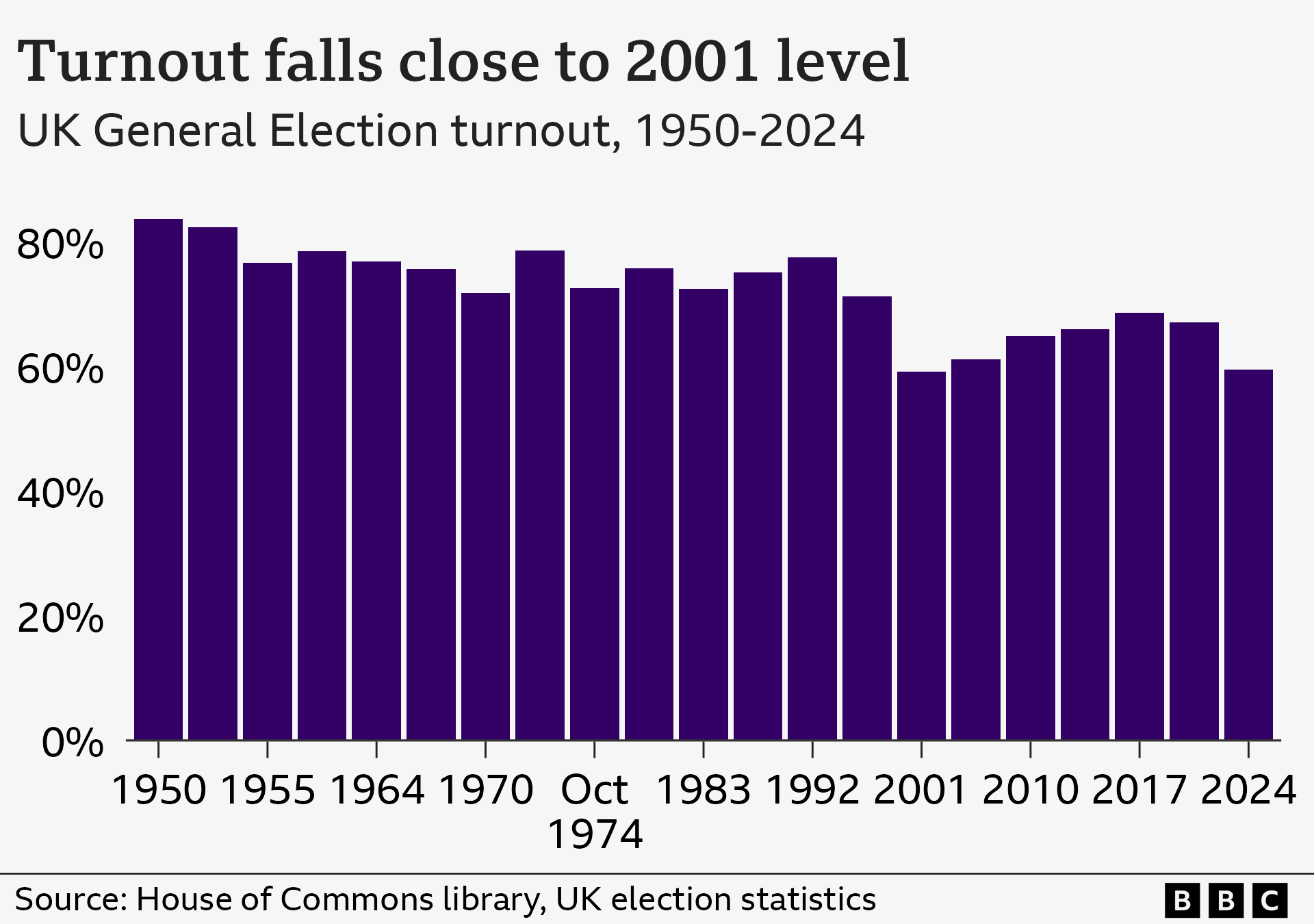General election 2024 in maps and charts

- Published
The Labour Party has won a landslide victory in the 2024 general election.
The party has taken 412 seats giving it a majority of 174.
It is the worst Conservative result in terms of seats in history, with the party on 121. The Liberal Democrats have their highest tally since 1923, taking 72 seats.
The SNP have nine seats. Reform UK have five and Plaid Cymru and the Green Party have four each.
Some 23 seats were won by other parties, all in Northern Ireland, and independent candidates.
The biggest gap on record has emerged between the share of the vote won nationally by parties and the number of seats they have gained.
Vote share
Labour gained over 200 seats but their vote share increased by less than two percentage points to 34%.
The Conservatives saw their vote share plummet by 20 points to 24% and the party lost 251 seats.
Reform are in third place by share of the vote on 14% but they found it difficult to convert votes into seats. The party has returned five MPs, including party leader Nigel Farage in Clacton.
By contrast, the Liberal Democrats’ 12% vote share translated into 72 seats.
The Greens recorded their best ever general election performance, winning four seats and seven per cent of the vote.

Changed hands
This map shows the seats which have been won by a different party to the last general election. To see all the results use the "Changed hands" toggle.
All of the new seats Keir Starmer's party took came from constituencies won by either the SNP or the Tories at the last general election. A total of 182 seats changed from blue to red.
All of Reform's gains came from seats previously won by the Conservative Party in 2019. Labour lost five seats to independent candidates, including former party leader Jeremy Corbyn in Islington North.
Labour also lost one seat, Leicester East, to the Conservatives and Bristol Central to the Greens.
Share by constituency
The Conservative vote share suffered particularly in areas where high numbers voted to leave the European Union, falling by 27 points in constituencies where more than 60% voted Leave.
Labour support in constituencies with large Muslim communities fell about 23 points to 39%.
Click through the slides on these maps to see constituency vote share by party.
Scotland
Scotland is the only part of the UK where Labour’s vote share rose sharply. It jumped by 17 points as the party took 36 seats from the SNP.
The SNP share of the vote is down 15 points. They also lost four seats to the Liberal Democrats.
The leader of the Scottish Conservatives, Douglas Ross, lost his seat in Aberdeenshire North and Moray East.
Wales
The Conservatives lost 12 seats in Wales, meaning they now have no MPs there.
Labour gained nine seats, taking the party's total to 27, despite their share falling by four points.
Plaid Cymru has gained two seats, putting the party on four and the Liberal Democrats have taken one seat.
Northern Ireland
Sinn Féin has become Northern Ireland's largest Westminster party, winning all seven seats it won in 2019, while the Democratic Unionist Party lost three of the eight it held at the last general election.
In a surprise result, Traditional Unionist Voice took North Antrim from the DUP, unseating Ian Paisley Jr.
Regional change
Looking at seat and vote share change across broad areas of England, the Conservatives have lost more than 100 seats in the South excluding London and their vote share is down by about 24 points.
Labour has made seat gains in the Midlands, North and South and has also increased its already-strong London tally by seven seats.
The Liberal Democrats have increased their seats in the South by more than 40, their highest regional tally.
Labour and Lib Dem vote shares fell somewhat in London, while hardly changing in the North and Midlands. Vote share for the two parties rose slightly in the South.
Reform share is up in all of these broad regions.
Turnout
Turnout across the UK as a whole is 60%, the second lowest in a UK election since 1885. Only 2001 was lower with 59%.

It was lowest in Wales, where only 56% of the electorate voted. Northern Ireland had a turnout of 57%, Scotland 59% and England 60%.
The lowest turnout of any constituency was 40% in Manchester Rusholme, where Afzal Khan held the seat for Labour. The bottom five for turnout also included Leeds South, Hull East, Blaenau Gwent & Rhymney and Tipton & Wednesbury.
Data journalists: Wesley Stephenson, Christine Jeavans, John Walton, Becky Dale, Callum Thomson, Dan Wainwright, Rob England, Phil Leake, Pilar Tomas, Aidan McNamee, Harriet Agerholm
Data scientists: Libby Rogers, Alison Benjamin, Jack Alston, Maryam Ahmed
Design: Muskeen Liddar
Related topics
- Published5 July 2024


